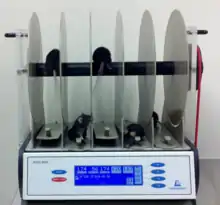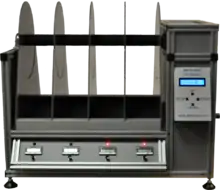Rotarod performance test
The rotarod performance test is a performance test based on a rotating rod with forced motor activity being applied, usually by a rodent. The test measures parameters such as riding time (seconds) or endurance. Some of the functions of the test include evaluating balance, grip strength and motor coordination of the subjects; especially in testing the effect of experimental drugs[1] or after traumatic brain injury.[2]

Rationale
In the test, a rodent is placed on a horizontally oriented, rotating cylinder (rod) suspended above a cage floor, which is low enough not to injure the animal, but high enough to induce avoidance of fall. Rodents naturally try to stay on the rotating cylinder, or rotarod, and avoid falling to the ground. The length of time that a given animal stays on this rotating rod is a measure of their balance, coordination, physical condition, and motor-planning. The speed of the rotarod is mechanically driven, and may either be held constant, or accelerated.[3]
A human analog to rotarod test might be treadmill running. Hamster, gerbil, and mouse owners can observe the principle in action when an animal climbs on the outside of its wheel, instead of inside of it. In the rotarod test, however, the rotation of the cylinder in experiments is mechanically driven.

Scientific use
The advantage of this test is that it creates a discretely measurable, continuous variable (length of time) that can be used for statistical purposes to quantify the effects of different drugs, conditions, and procedures. This test does not use subjective judgments of ability, and inter-rater reliability will be virtually perfect. Inter-laboratory reliability will only be achieved if the various parameters (size of cylinder, speed of cylinder, composition material of surface, and amount of practice/training given the animal) are also replicated.[4] The experiment is also very replicable from lab to lab (ibid). Moreover, these parameters may be adjusted variously to optimize the statistical separation of different conditions. For instance, alcohol effects on mice become less apparent when the speed is increased.[5]
Because of concern for impairment in human motor behavior from the use of prescription medications, the rotarod test is frequently used in early stages of drug development[6] to screen out drugs that might later cause subtle impairments, which might not be detected epidemiologically in a human population for a very long time. The test may be useful as a sensitive indicator of trauma induced by brain injury to laboratory rats. [7] Alcohol markedly impairs mouse performance in the rotarod test.[8] Research using the rotarod test with various chemical agonists and antagonists may help scientists determine which components of neurons mediate the effects of chemicals.[9] Testing of genetic knockout animals may help determine the genes most responsible for maintaining mammalian balance and coordination.[10] Comparing the performance of different animals with specific brain lesions helps scientists map which structures are critical for maintaining balance.[11]
References
- "Rotarod Performance Test definition". Archived from the original on 2008-07-25. Retrieved 2009-11-19.
- Mouzon, B; Chaytow, H (February 2012). "Repetitive Mild Traumatic Brain Injury in a Mouse Model Produces Learning and Memory Deficits Accompanied by Histological Changes" (PDF). J Neurotrauma. 29 (18): 2761–73. doi:10.1089/neu.2012.2498. PMID 22900595.
- Jones, BJ; Roberts, DJ (Apr 1968). "The quantitative measurement of motor inco-ordination in naive mice using an accelerating rotarod". J Pharm Pharmacol. 20 (4): 302–4. doi:10.1111/j.2042-7158.1968.tb09743.x. PMID 4384609. S2CID 96471407.
- Proc Natl Acad Sci U S A. 2003 March 4; 100(5): 2917–2922 Assessment of genetic susceptibility to ethanol intoxication in miceNathan R. Rustay,*† Douglas Wahlsten,‡ and John C. Crabbe
- Rustay, N. R., Wahlsten, D. & Crabbe, J. C. (2003) Behav. Brain Res.
- Stemmelin, J; Cohen, C; Terranova, JP; Lopez-Grancha, M; Pichat, P; Bergis, O; Decobert, M; Santucci, V; Françon, D; Alonso, R; Stahl, SM; Keane, P; Avenet, P; Scatton, B; Fur, G; Griebel, G (Feb 2008). "Stimulation of the beta3-Adrenoceptor as a novel treatment strategy for anxiety and depressive disorders". Neuropsychopharmacology. 33 (3): 574–87. doi:10.1038/sj.npp.1301424. PMID 17460614.
- Hamm, RJ; Pike, BR; O'Dell, DM; Lyeth, BG; Jenkins, LW (Apr 1994). "The rotarod test: an evaluation of its effectiveness in assessing motor deficits following traumatic brain injury". J Neurotrauma. 11 (2): 187–96. doi:10.1089/neu.1994.11.187. PMID 7932797.
- Bogo, V; Hill, TA; Young, RW (Dec 1981). "Comparison of accelerod and rotarod sensitivity in detecting ethanol- and acrylamide-induced performance decrement in rats: review of experimental considerations of rotating rod systems". Neurotoxicology. 2 (4): 765–87. PMID 7200586.
- Millan, MJ; Bervoets, K; Rivet, JM; Widdowson, P; Renouard, A; Le Marouille-Girardon, S; Gobert, A (Sep 1994). "Multiple alpha-2 adrenergic receptor subtypes. II. Evidence for a role of rat R alpha-2A adrenergic receptors in the control of nociception, motor behavior and hippocampal synthesis of noradrenaline". J Pharmacol Exp Ther. 270 (3): 958–72. PMID 7932208.
- Minasyan, A; Keisala, T; Zou, J; Zhang, Y; Toppila, E; Syvälä, H; Lou, YR; Kalueff, AV; Pyykkö, I; Tuohimaa, P (Apr 2009). "Vestibular dysfunction in vitamin D receptor mutant mice". J Steroid Biochem Mol Biol. 114 (3–5): 161–6. doi:10.1016/j.jsbmb.2009.01.020. PMID 19429446. S2CID 34877945.
- Haelewyn, B; Freret, T; Pacary, E; Schumann-Bard, P; Boulouard, M; Bernaudin, M; Bouët, V (Mar 2007). "Long-term evaluation of sensorimotor and mnesic behaviour following striatal NMDA-induced unilateral excitotoxic lesion in the mouse". Behav. Brain Res. 178 (2): 235–43. doi:10.1016/j.bbr.2006.12.023. PMID 17250902. S2CID 43080097.